Gillingham F.C.
| Full name | Gillingham Football Club | ||||||||||||||||||||||||||
|---|---|---|---|---|---|---|---|---|---|---|---|---|---|---|---|---|---|---|---|---|---|---|---|---|---|---|---|
| Nickname(s) | The Gills | ||||||||||||||||||||||||||
| Founded | 1893 (as New Brompton) | ||||||||||||||||||||||||||
| Ground | KRBS Priestfield Stadium Gillingham (Capacity: 11,582[1]) |
||||||||||||||||||||||||||
| Chairman | |||||||||||||||||||||||||||
| Manager | |||||||||||||||||||||||||||
| League | League Two | ||||||||||||||||||||||||||
| 2007–08 | League One, 22nd (relegated)[3] |
||||||||||||||||||||||||||
|
|||||||||||||||||||||||||||
Gillingham Football Club is an English professional football club based in the town of Gillingham, Kent. The only Kent-based club in the Football League, they play their home matches at the KRBS Priestfield Stadium. In the 2007–08 season, the club was relegated from Football League One.
The club was founded in 1893 and joined the Football League in 1920. They were voted out of the league in favour of Ipswich Town at the end of the 1937–38 season, but returned to it 12 years later after it was expanded from 88 to 92 clubs. Twice in the late 1980s they came close to winning promotion to the second tier of English football, but a decline then set in and in 1993 they narrowly avoided relegation to the Football Conference. Between 2000 and 2005, Gillingham were in the second tier of the English league for the only time in their history, achieving a club record highest league finish of eleventh place in 2002–03.
Contents |
History
-
For more details on this topic, see History of Gillingham F.C..
- For a statistical breakdown by season, see Gillingham F.C. seasons
Early years
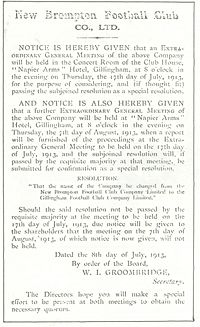
In May 1893, the local success of a junior football side, Chatham Excelsior F.C., encouraged a group of businessmen to meet with a view to creating a football club which could compete in larger competitions.[4] New Brompton F.C. was formed from the meeting, incorporating a number of Excelsior players. The gentlemen also purchased the plot of land which would later become Priestfield Stadium.[5] The new club played its first match on 2 September 1893, losing 1–5 to Woolwich Arsenal's reserve side in front of a crowd of 2,000.[6] New Brompton were among the founder members of the Southern League upon its creation in 1894, and were placed in Division Two. They were named Champions in the first season (1894–95) going on to defeat Swindon Town in a test match to win promotion.[7]
In the seasons that followed, the club struggled in Division One, finishing bottom in the 1907–08 season,[3] avoiding relegation only due to expansion of the league. Whilst the club's league performance was disappointing, the side did manage a famous cup victory over Football League First Division Sunderland and held Manchester City to a draw before losing in the replay.[8] In 1913 the club renamed itself Gillingham F.C.[9] but performances remained disappointing. The team finished bottom of Division One in the 1919–20 season but for a third time avoided relegation, due to the subsequent elevation of all Southern League Division One clubs to form the new Football League Division Three.[10]
First spell in the Football League
In the first season of the newly-created Football League Division Three, the 1920–21 season, Gillingham again finished bottom, and in the years to follow there was little improvement on this, the club continually finishing in the lower reaches of the bottom division. In 1938 the team finished bottom of the Third Division (South) and were required to apply for re-election for the fifth time since joining the league. This bid for re-election failed, with Gillingham returning to the Southern League and Ipswich Town being promoted in their place.[11] Gillingham quickly established themselves as one of the stronger sides in the league, winning a local double of the Kent League and Kent Senior Cup in the 1945–46 season.[11] In the 1946–47 season the team won both the Southern League Cup and the Southern League championship, during which they recorded a club record 12–1 victory over Gloucester City.[12] The Gills also won the league title in 1948–49.[13]
Return to the Football League
In 1950 plans were announced to expand the Football League Division Three (South) from 22 to 24 teams and, taking into account their local success in the interim, Gillingham were re-elected to the Football League with a landslide vote.[13] The team spent eight seasons in Division Three (South) before the restructuring of the league system for the 1958–59 season saw them placed in the newly-created Fourth Division. They remained in this division until 1964, when manager Freddie Cox led them to promotion, winning the first and so far only championship in the club's history. The team finished the season level on 60 points with Carlisle United, but with a better goal average (1.967 against 1.948), which was the tightest league title finish in Football League history.[14]
After relegation back to the Fourth Division in 1970–71, the Gills were soon promoted back to the Third Division in the 1973–74 season.[15] After this the club seemed to find its level in Division Three, regularly mounting a challenge for promotion which ultimately fell short each time, never more so than in 1986–87 when they reached the play-offs only to lose in the final to Swindon Town.[16] During this period the club produced future stars Steve Bruce and Tony Cascarino, who was famously bought from non-league Crockenhill in exchange for a set of tracksuits.[17]
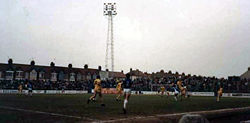
In 1987 the Gills hit the headlines when, on consecutive Saturdays, they beat Southend United 8–1 and Chesterfield 10–0, the latter a club record for a Football League match. Just a few months later, however, manager Keith Peacock was controversially sacked[18] and within 18 months the club had fallen into Division Four.[16] The ensuing spell in the lower division brought little success, and in the 1992–93 Division Three campaign the Gills narrowly avoided relegation to the Football Conference.[16]
Recent highs and lows
Beset with financial problems, the club went into administration in January 1995, and by the end of the 1994–95 season faced the threat of being expelled from the Football League and closed down.[16] In June 1995, however, a London-based businessman, Paul Scally, stepped in and bought the club.[19] He brought in new manager Tony Pulis, who led Gillingham to promotion in his first season, finishing second in the old Division Three (now Football League Two).[3] In 1999 the Gills made the play-offs but lost in the Division Two play-off final to Manchester City. The Gills were 2–0 up with less than two minutes left only to see City score twice, the equaliser in injury time, and go on to win 3–1 in a penalty shoot-out.[20]
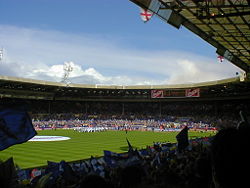
Soon after the play-off loss, Pulis was sacked for gross misconduct,[21] and Peter Taylor appointed manager.[22] In the 1999–00 season Gillingham qualified for the play-offs again, where they faced Wigan Athletic in the final at Wembley Stadium. The game finished 1–1 after 90 minutes, but, thanks to goals in extra time from substitutes Steve Butler and Andy Thomson, the Gills won 3–2 and were promoted to Division One for the first time.[20]
Taylor then left to manage Leicester City, and Andy Hessenthaler was appointed as player-manager.[23] He led the club to their best ever league finish of eleventh in the 2002–03 season,[3] but the following season saw the club narrowly avoid relegation on goal difference. Hessenthaler resigned as manager in November 2004,[23] and new boss Stan Ternent[24] was unable to prevent the Gills' relegation to League One. At the end of the 2007–08 season the club was relegated again, this time to League Two.[25]
Stadium
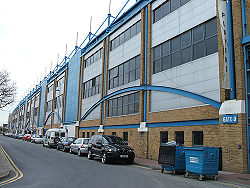
The Gills have played at Priestfield Stadium throughout their existence.[26] The ground was originally purchased by the founders of the club through an issue of 1,500 £1 shares.[5] Sources differ on whether the ground was named after the road on which the land stood, Priestfield Road,[5] or whether the road was named after the ground;[27] if the latter is the case then the origin of the ground's name is unknown. The ground was extensively developed prior to the 1930s, but there was then little change until the late 1990s and the arrival of Paul Scally as chairman. Three of the four stands were demolished and rebuilt between 1995 and 2000. The fourth stand, known as the Town End, was demolished to make way for a new stand, to be named the Brian Moore Stand after television sports commentator Brian Moore, who was a well-known Gills fan, but the club's financial situation has not allowed the new stand to be built and a temporary stand has been in place since 2004.[28] On 1 June 2007 the stadium was officially renamed KRBS Priestfield Stadium as part of a new sponsorship deal with the Kent Reliance Building Society.[29]
At its peak in the 1940s the official capacity of the stadium was listed as "between 25,000 and 30,000"[4] but subsequent redevelopments, the removal of terraces and building of new facilities have seen this reduced to a current capacity of 11,582.[1] In the 2007–08 season, the average attendance at home matches was 6,077, just 52% of capacity.[30] The ground has also hosted home fixtures of the England women's national football team.[31]
Colours and crest
|
|
|||||||||
| New Brompton's original kit in 1893 | |||||||||
Although Gillingham have long been associated with the colours blue and white, the original New Brompton side wore a strip consisting of black and white striped shirts with black shorts.[5] With the renaming of the club in 1913, the black and white strip was dropped in favour of red shirts with blue sleeves,[32] emblazoned with the borough's coat of arms. The striped shirts returned after World War One, before finally being replaced with the now-familiar combination of plain blue shirts and white shorts in 1931.[32]
More recent years have seen several variations on the blue and white colour scheme. Several late 1990s strips featured blue and black striped shirts, recalling the original New Brompton stripes.[32]
In the summer of 2003 it was controversially announced that the club's first choice shirts for the following season would be predominantly white, rather than blue. The announcement received such a hostile response from supporters that the white strip was replaced by one featuring blue and black hoops, which had originally been earmarked as the team's third choice kit.[33]
The club's current crest is a shield divided vertically into halves of black and white stripes and solid blue, reflecting the club's original and modern kits. On the blue half is the county emblem of Kent, a white horse rampant, albeit slightly altered from its normal form as its mane is stylised into the letters of the word "Gills". The club's motto, which appears on a scroll below the crest, is "Domus clamantium", the Latin for "the home of the shouting men",[34] an epithet associated with the town of Gillingham for several hundred years.[35]
The first sponsor's name to appear on Gillingham shirts was that of Italian home appliance manufacturers Zanussi, who sponsored the club from 1984 to 1987. Subsequent sponsors have been Chatham Maritime (1987 to 1991), Medway Toyota (1991 to 1994), Cannon Tool Hire (1994 to 1995), Invicta FM (1995 to 1997), Kool (1997 to 1999), Medway News (1999 to 2001), SeaFrance (2001 to 2004) and MHS Homes Group (2004 to 2007).[32] Since the start of the 2007–08 season the team's shirts have been sponsored by the Kent Reliance Building Society as part of the deal which also involves the renaming of the club's stadium.[29]
Players
Current squad
- As of 8 October 2008:[36]
|
|
The club also fields a youth team at Under-18 level[37] and operates a Centre of Excellence for boys in the Under-9 to Under-16 age groups.[38]
Notable former players
International players
The club recognises nine players as having gained full international caps during their time at Priestfield, although the status of one of these (that of Freddie Fox) is disputed.
| Player | Country | Caps | Notes | |
| Andrew Crofts | Wales | 12 | [39] | |
| Ian Cox | Trinidad and Tobago | 11 | [16] | |
| Mamady Sidibe | Mali | 7 | [16] | |
| Brent Sancho | Trinidad and Tobago | 6 | [16] | |
| Tony Cascarino | Republic of Ireland | 3 | [16] | |
| Terry Cochrane | Northern Ireland | 2 | [16] | |
| Damien Richardson | Republic of Ireland | 2 | [16] | |
| Jason Brown | Wales | 1 | [40] | |
| Freddie Fox | England | 1 | [41] |
In 2006 Sancho became the first Gillingham player ever to play in the World Cup finals, and technically the first to score in the World Cup finals when he scored an own goal in the 2-0 group defeat to Paraguay.[42]
Back room staff
As at 14 April 2008:[43]
Directors
- Chairman/Chief Executive: Paul Scally
- Chief Executive: Mark Jones
- Director of Sales: John Holmes
- Vice chairman: Peter Spokes
- Non-executive director: Mike Quarrington
- Associate director: Yvonne Paulley
Management
- Team manager: Mark Stimson
- Assistant manager: Scott Barrett
- First team coach: Mark Robson
- Fitness coach: Danny Ellis
- Youth team manager: Mark Patterson
- Senior physiotherapist: Paul Smith
Managers
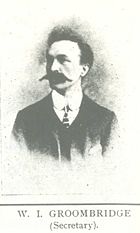
-
For more details on this topic, see List of Gillingham F.C. managers.
As of November 2007, a total of 31 men have been appointed as manager of Gillingham since the post was first established, not including caretaker managers.[44] This total includes Robert Brown, who was formally appointed manager in May 1920 but resigned without ever taking charge of a match.
|
|
Chairmen
The following men have been chairman of the club's Board of Directors:[46]
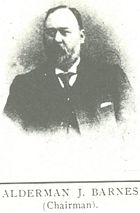
|
|
Honours
- Football League Fourth Division
- Champions 1963–64, runners-up 1973–74
- Football League Third Division
- Runners-up 1995–96
- Football League Second Division
- Play-off winners 1999–00, finalists 1986–87 & 1998–99
- Southern Football League
- Champions 1946–47 & 1948–49, runners up 1947–48
- Southern Football League Division Two
- Champions 1894–95
- Southern League Cup
- Winners 1946–47
- Kent League
- Champions 1945–46
- Kent League Cup
- Winners 1945–46
- Kent Senior Cup
- Winners 1945–46 & 1947–48, runners-up 1938–39, 1948–49, 1949–50 & 1994–95
Statistics and records
-
For more details on this topic, see Gillingham F.C. records.
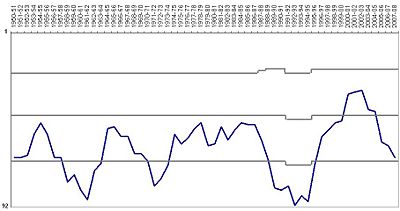
Horizontal grey lines indicate league divisions.
Goalkeeper Ron Hillyard holds the record for Gillingham appearances, having played 657 matches in all competitions between 1974 and 1990,[50] while the record for appearances solely in the Football League is held by another goalkeeper, John Simpson, with 571 between 1957 and 1972.[51] Brian Yeo is the club's all-time leading league goalscorer, having scored a total of 136 goals between 1963 and 1975.[52] He also jointly holds the record for the most Football League goals scored in a single season, having scored 31 goals in the 1973–74 season,[52] equalling the record set by Ernie Morgan in 1954–55.[53] The highest number of goals scored by a player in a single game at a professional level is the six registered by Fred Cheesmur against Merthyr Town in April 1930.[54]
The club's record home attendance is 23,002, for an FA Cup match against QPR on 10 January 1948,[51] a record which will almost certainly never be broken unless the club relocates to a larger ground, given that Priestfield Stadium's current capacity is approximately half that figure.
The team's biggest ever professional win was a 10-0 defeat of Chesterfield in September 1987,[51] although they had previously registered a 12-1 win against Gloucester City in the Southern League in November 1946.[16]
The Gills hold the record for the fewest goals conceded by a team in the course of a 46 game season,[55] having conceded just 20 in the 1995–96 season,[3] during which goalkeeper Jim Stannard kept 29 clean sheets.[51]
Rivalries
A 2003 fan survey revealed that no other team's supporters considered Gillingham to be among their club's main rivals.[56] Millwall are considered to be the closest the Gills have to local rivals.[57] Swindon Town are seen by many fans as the club's biggest rivals, stemming from bad-tempered matches between the two teams in the past.[58] While Swindon fans generally do not consider Gillingham their biggest rivals, there was violence when they met at Priestfield in the 2005–06 season, their first meeting since a promotion play-off match in 1987.[59] Following their promotion in 1989, Maidstone United became Kent's second League side. A rivalry with Gillingham developed over the following seasons, until Maidstone's financial troubles forced them to resign from the League in 1992.[60]
Gillingham in popular culture
The 2005 film Green Street (known as Green Street Hooligans in the USA) makes use of action sequences filmed during a match between Gillingham and West Ham United, although for unknown reasons the dialogue states that the team playing West Ham is Birmingham City.[61]
See also
- Brian Moore's Head Looks Uncannily Like London Planetarium - webzine devoted to the club, which previously existed from 1988 to 2006 as a paper fanzine. Named in honour of the club's most famous supporter, the late commentator Brian Moore.
References
- ↑ 1.0 1.1 "Gillingham – Priestfield Stadium". Yorkshire Evening Post (2007-06-27). Retrieved on 2008-10-02.
- ↑ "New manager at KRBS Priestfield". Gillingham F.C. (2007-11-01). Retrieved on 2007-11-01.
- ↑ 3.0 3.1 3.2 3.3 3.4 "Gillingham". The Football Club History Database. Retrieved on 2007-04-11.
- ↑ 4.0 4.1 Triggs, Roger (1984). Gillingham Football Club: A Chronology 1893–1984. Kent County Libraries. pp. p1.
- ↑ 5.0 5.1 5.2 5.3 Triggs. Gillingham Football Club: A Chronology 1893–1984. pp. p8.
- ↑ Triggs. Gillingham Football Club: A Chronology 1893–1984. pp. p4.
- ↑ Triggs. Gillingham Football Club: A Chronology 1893–1984. pp. p5.
- ↑ Triggs. Gillingham Football Club: A Chronology 1893–1984. pp. p6.
- ↑ Triggs. Gillingham Football Club: A Chronology 1893–1984. pp. p9.
- ↑ Triggs. Gillingham Football Club: A Chronology 1893–1984. pp. p10.
- ↑ 11.0 11.1 Triggs. Gillingham Football Club: A Chronology 1893–1984. pp. p13.
- ↑ Triggs. Gillingham Football Club: A Chronology 1893–1984. pp. p16.
- ↑ 13.0 13.1 Triggs. Gillingham Football Club: A Chronology 1893–1984. pp. p19.
- ↑ Triggs. Gillingham Football Club: A Chronology 1893–1984. pp. p26.
- ↑ Triggs. Gillingham Football Club: A Chronology 1893–1984. pp. p54.
- ↑ 16.00 16.01 16.02 16.03 16.04 16.05 16.06 16.07 16.08 16.09 16.10 "Gillingham FC History (1893– )". Gillingham F.C.. Retrieved on 2008-01-09.
- ↑ Matt Davison (2007-09-24). "Past Players: Tony Cascarino". Gillingham F.C.. Retrieved on 2008-01-07.
- ↑ "Football: Gillingham dismiss Peacock as manager", The Times (1987-12-30). Retrieved on 2008-09-30.
- ↑ David Powell (1995-10-09). "Gillingham find a new way forward – Football". The Times. Retrieved on 2008-09-30.
- ↑ 20.0 20.1 "Play-Off Finals". The Football League. Retrieved on 2007-04-11.
- ↑ Mike Taylor (2001-04-27). "Football: Pulis denies engineering Gills sacking". The Independent. Retrieved on 2008-01-07.
- ↑ "Taylor-made for top job". BBC Sport. Retrieved on 2007-04-18.
- ↑ 23.0 23.1 "Hessenthaler steps down at Gills". BBC Sport. Retrieved on 2007-04-12.
- ↑ "Gills unveil Ternent as manager". BBC Sport. Retrieved on 2007-04-12.
- ↑ "Leeds 2–1 Gillingham". BBC (2008-05-03). Retrieved on 2008-05-03.
- ↑ "Ground history for Gillingham". Soccerbase. Retrieved on 2007-04-11.
- ↑ "Local history: Gillingham Football Club". Medway Council. Retrieved on 2007-04-11.
- ↑ "The Changing Face of KRBS Priestfield". Gillingham F.C. (2007-09-07). Retrieved on 2008-01-09.
- ↑ 29.0 29.1 "Gillingham to change stadium name". BBC (2007-03-19). Retrieved on 2008-01-08.
- ↑ "Football League Official Stats". The Football League. Retrieved on 2008-06-25.
- ↑ "Powell impressed with Kent crowd". BBC (2006-04-21). Retrieved on 2007-11-07.
- ↑ 32.0 32.1 32.2 32.3 "Gillingham". www.historicalkits.co.uk. Retrieved on 2007-04-11.
- ↑ "Shirty fans win kit battle". BBC (2003-06-19). Retrieved on 2008-01-09.
- ↑ Lawrence Booth and Nial Briggs (2004-08-31). "Which clubs have Latin on their badges?". Guardian Unlimited. Retrieved on 2007-04-30.
- ↑ Steve Tongue (1999-05-29). "Football: Forgotten club ready to surprise". The Independent. Retrieved on 2007-04-30.
- ↑ "2008/09 squad numbers announced". Gillingham F.C. (2008-07-02). Retrieved on 2008-07-02.
- ↑ "Youth Fixtures". Gillingham F.C.. Retrieved on 2007-09-08.
- ↑ "Centre of Excellence". Gillingham F.C.. Retrieved on 2007-09-08.
- ↑ "Crofts collects twelfth cap". Gillingham F.C. (2008-06-01). Retrieved on 2008-06-02.
- ↑ "Gills keeper seals Blackburn move". BBC Sport (2006-06-26). Retrieved on 2008-09-17.
- ↑ The history page on the official Gillingham F.C. website lists Fox as having gained his one England cap whilst with the club. Triggs (2001) repeats this claim but states elsewhere in the book that Fox was transferred from Gillingham to Millwall in April 1925, a month before his only England appearance. The Rec.Sport.Soccer Statistics Foundation lists him as a Millwall player at the time of the England match.
- ↑ "Paraguay 2-0 Trinidad and Tobago". BBC Sport. Retrieved on 2007-04-11.
- ↑ "Who's Who at Gillingham Football Club". Gillingham F.C.. Retrieved on 2007-08-09.
- ↑ "Manager History for Gillingham". Soccerbase. Retrieved on 2007-04-11.
- ↑ A 1906 document reprinted in Triggs (1984) gives Groombridge's title as "secretary" rather than the modern "manager". This was generally the case during the early years of the twentieth century, and may also apply to some of Groombridge's successors.
- ↑ Bradley, Andy; Roger Triggs (1994). Home of the Shouting Men: Complete History of Gillingham Football Club 1893–1993. Gillingham F.C.. pp. p.392. ISBN 0-9523-3610-3.
- ↑ Trevor Haylett (1995-01-10). "Everton fail to win Saunders". The Independent. Retrieved on 2008-06-26.
- ↑ David Conn (2008-03-26). "Uncertain future turns fans green about the Gills". The Guardian. Retrieved on 2008-06-26.
- ↑ Paul Kelso (2002-02-15). "Scally's rocky road to Highbury". The Guardian. Retrieved on 2008-06-26.
- ↑ Triggs. The Men Who Made Gillingham Football Club. pp. p158.
- ↑ 51.0 51.1 51.2 51.3 "Gillingham all time records". Soccerbase. Retrieved on 2007-04-11.
- ↑ 52.0 52.1 Triggs. The Men Who Made Gillingham Football Club. pp. p344.
- ↑ Triggs. The Men Who Made Gillingham Football Club. pp. p226.
- ↑ Triggs. The Men Who Made Gillingham Football Club. pp. p349.
- ↑ The official Football League website lists this achievement in second place on the overall list of teams who have conceded the fewest goals in a season, behind Liverpool, who conceded 16 in the 1978–79 season, however, as evidenced by the final 1978–79 First Division table, Liverpool played only 42 matches, giving Gillingham the record for a 46-match season.
- ↑ "Rivalry Uncovered!". The Football Fans Census. Retrieved on 2007-04-11.
- ↑ "Millwall 1–2 Gillingham". BBC (2001-11-24). Retrieved on 2008-10-02.
- ↑ "Gillingham vs Swindon Town". Gillingham F.C. (2006-01-14). Retrieved on 2008-10-02.
- ↑ "Town set to pay price for crowd trouble". Swindon Advertiser. Retrieved on 2007-04-11.
- ↑ Simon O'Hagan (1996-01-10). "Butler's hat-trick lifts Gillingham to top". The Independent. Retrieved on 2008-10-02.
- ↑ "Hooligans". Internet Movie Database. Retrieved on 2007-04-12.
External links
- Official club website
- Gillingham F.C. on BBC Sport: Club News - Recent results - Upcoming fixtures - Club stats
- Gills Connect fansite
|
Gillingham Football Club
|
||||||||||||||||||||||||||||||||||||||||
|---|---|---|---|---|---|---|---|---|---|---|---|---|---|---|---|---|---|---|---|---|---|---|---|---|---|---|---|---|---|---|---|---|---|---|---|---|---|---|---|---|
|
||||||||||||||||||||||||||||||||||||||||
|
Football League Two 2008–09
|
||||||||||||||||||||||||||||||||||||||||
|
||||||||||||||||||||||||||||||||||||||||
|
||||||||||||||||||||||||||||||||||||||||